Health Service Delivery in Rural and Remote Contexts
VerifiedAdded on 2023/06/03
|14
|3675
|406
AI Summary
This essay discusses the challenges of healthcare delivery in rural and remote areas in Australia, including contemporary remote health practice, models of medical care, and difficulties in enrolling and retaining committed professionals. It also highlights the social and economic inequalities in accessing health services, problems in recruitment, unfavorable ecological conditions, and professional hazards of dangers at the workplace.
Contribute Materials
Your contribution can guide someone’s learning journey. Share your
documents today.
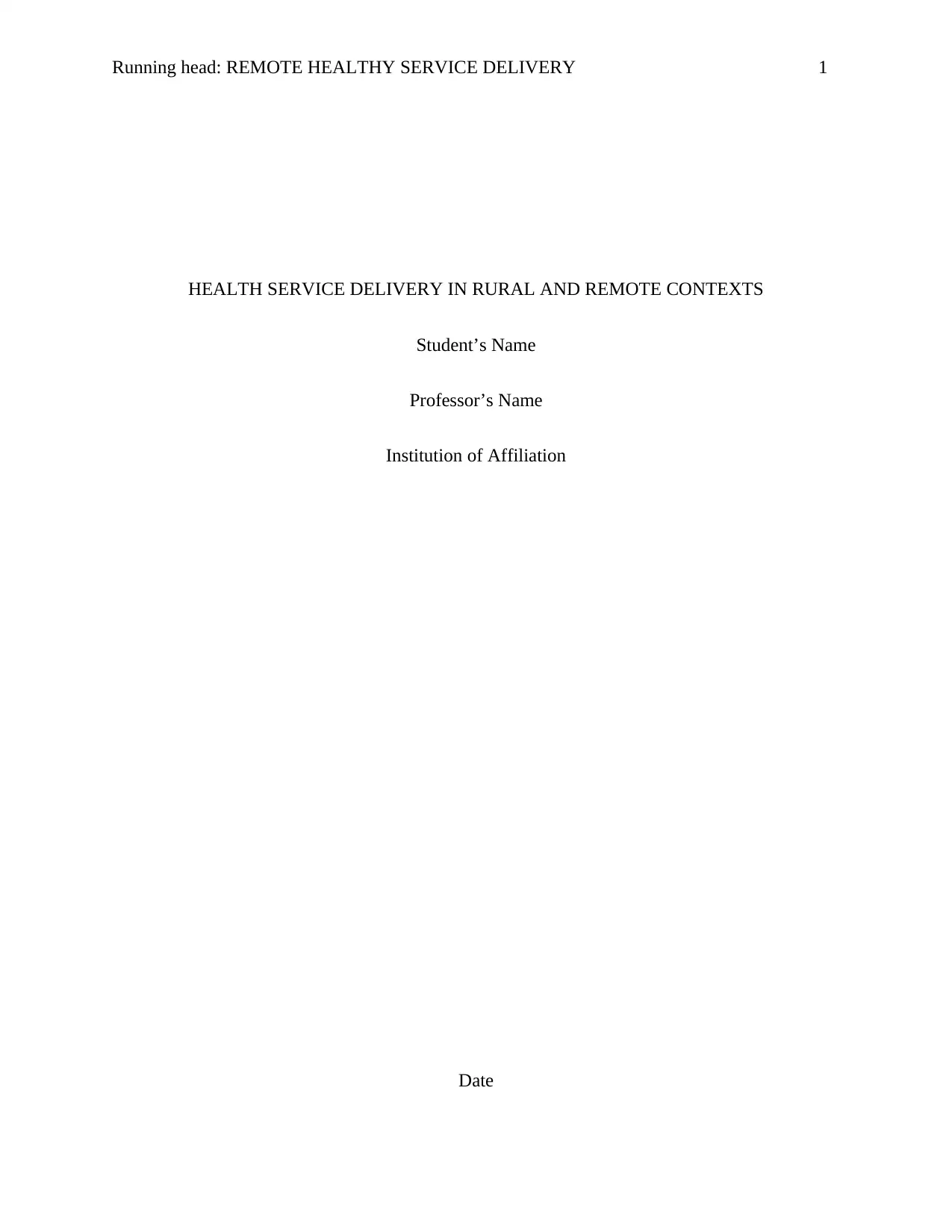
Running head: REMOTE HEALTHY SERVICE DELIVERY 1
HEALTH SERVICE DELIVERY IN RURAL AND REMOTE CONTEXTS
Student’s Name
Professor’s Name
Institution of Affiliation
Date
HEALTH SERVICE DELIVERY IN RURAL AND REMOTE CONTEXTS
Student’s Name
Professor’s Name
Institution of Affiliation
Date
Secure Best Marks with AI Grader
Need help grading? Try our AI Grader for instant feedback on your assignments.
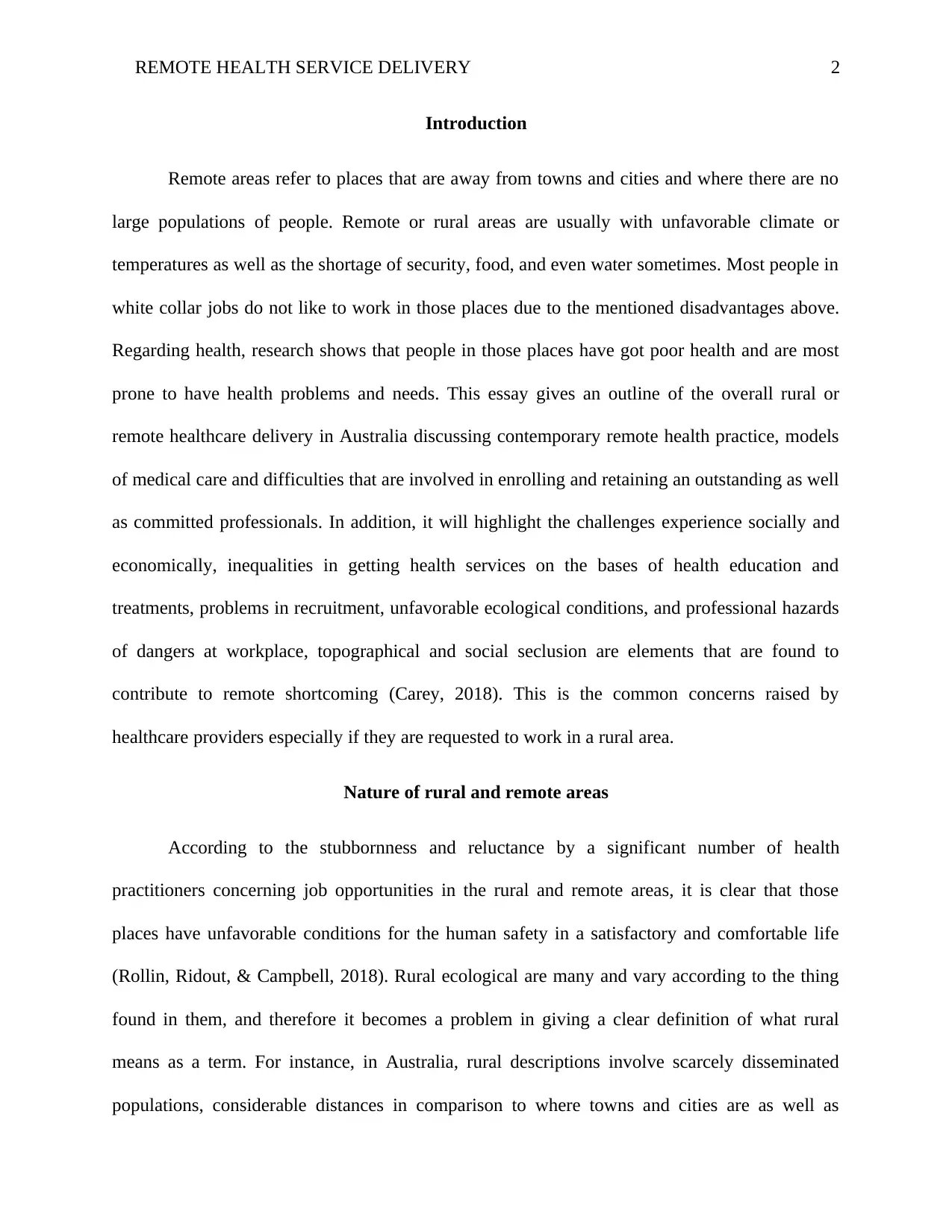
REMOTE HEALTH SERVICE DELIVERY 2
Introduction
Remote areas refer to places that are away from towns and cities and where there are no
large populations of people. Remote or rural areas are usually with unfavorable climate or
temperatures as well as the shortage of security, food, and even water sometimes. Most people in
white collar jobs do not like to work in those places due to the mentioned disadvantages above.
Regarding health, research shows that people in those places have got poor health and are most
prone to have health problems and needs. This essay gives an outline of the overall rural or
remote healthcare delivery in Australia discussing contemporary remote health practice, models
of medical care and difficulties that are involved in enrolling and retaining an outstanding as well
as committed professionals. In addition, it will highlight the challenges experience socially and
economically, inequalities in getting health services on the bases of health education and
treatments, problems in recruitment, unfavorable ecological conditions, and professional hazards
of dangers at workplace, topographical and social seclusion are elements that are found to
contribute to remote shortcoming (Carey, 2018). This is the common concerns raised by
healthcare providers especially if they are requested to work in a rural area.
Nature of rural and remote areas
According to the stubbornness and reluctance by a significant number of health
practitioners concerning job opportunities in the rural and remote areas, it is clear that those
places have unfavorable conditions for the human safety in a satisfactory and comfortable life
(Rollin, Ridout, & Campbell, 2018). Rural ecological are many and vary according to the thing
found in them, and therefore it becomes a problem in giving a clear definition of what rural
means as a term. For instance, in Australia, rural descriptions involve scarcely disseminated
populations, considerable distances in comparison to where towns and cities are as well as
Introduction
Remote areas refer to places that are away from towns and cities and where there are no
large populations of people. Remote or rural areas are usually with unfavorable climate or
temperatures as well as the shortage of security, food, and even water sometimes. Most people in
white collar jobs do not like to work in those places due to the mentioned disadvantages above.
Regarding health, research shows that people in those places have got poor health and are most
prone to have health problems and needs. This essay gives an outline of the overall rural or
remote healthcare delivery in Australia discussing contemporary remote health practice, models
of medical care and difficulties that are involved in enrolling and retaining an outstanding as well
as committed professionals. In addition, it will highlight the challenges experience socially and
economically, inequalities in getting health services on the bases of health education and
treatments, problems in recruitment, unfavorable ecological conditions, and professional hazards
of dangers at workplace, topographical and social seclusion are elements that are found to
contribute to remote shortcoming (Carey, 2018). This is the common concerns raised by
healthcare providers especially if they are requested to work in a rural area.
Nature of rural and remote areas
According to the stubbornness and reluctance by a significant number of health
practitioners concerning job opportunities in the rural and remote areas, it is clear that those
places have unfavorable conditions for the human safety in a satisfactory and comfortable life
(Rollin, Ridout, & Campbell, 2018). Rural ecological are many and vary according to the thing
found in them, and therefore it becomes a problem in giving a clear definition of what rural
means as a term. For instance, in Australia, rural descriptions involve scarcely disseminated
populations, considerable distances in comparison to where towns and cities are as well as
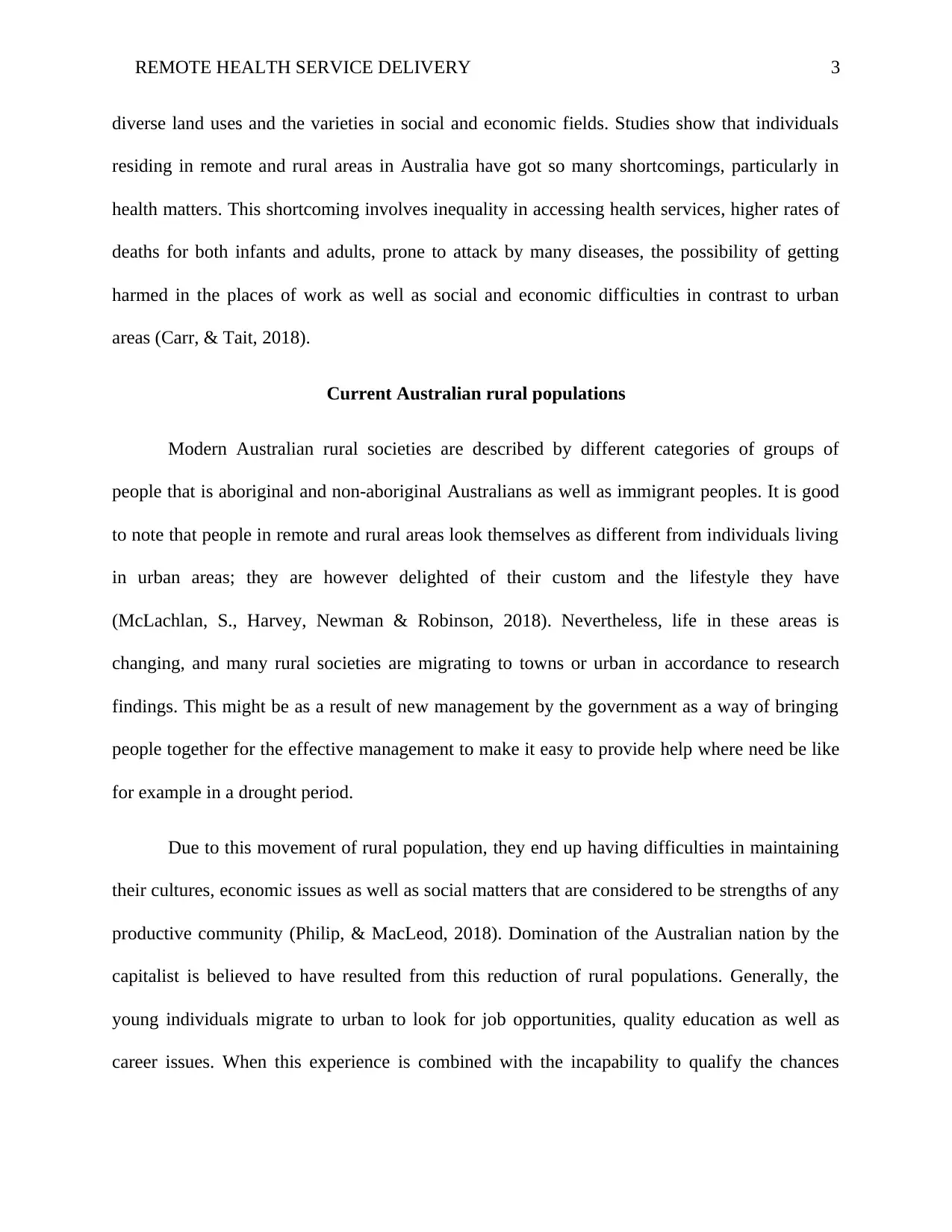
REMOTE HEALTH SERVICE DELIVERY 3
diverse land uses and the varieties in social and economic fields. Studies show that individuals
residing in remote and rural areas in Australia have got so many shortcomings, particularly in
health matters. This shortcoming involves inequality in accessing health services, higher rates of
deaths for both infants and adults, prone to attack by many diseases, the possibility of getting
harmed in the places of work as well as social and economic difficulties in contrast to urban
areas (Carr, & Tait, 2018).
Current Australian rural populations
Modern Australian rural societies are described by different categories of groups of
people that is aboriginal and non-aboriginal Australians as well as immigrant peoples. It is good
to note that people in remote and rural areas look themselves as different from individuals living
in urban areas; they are however delighted of their custom and the lifestyle they have
(McLachlan, S., Harvey, Newman & Robinson, 2018). Nevertheless, life in these areas is
changing, and many rural societies are migrating to towns or urban in accordance to research
findings. This might be as a result of new management by the government as a way of bringing
people together for the effective management to make it easy to provide help where need be like
for example in a drought period.
Due to this movement of rural population, they end up having difficulties in maintaining
their cultures, economic issues as well as social matters that are considered to be strengths of any
productive community (Philip, & MacLeod, 2018). Domination of the Australian nation by the
capitalist is believed to have resulted from this reduction of rural populations. Generally, the
young individuals migrate to urban to look for job opportunities, quality education as well as
career issues. When this experience is combined with the incapability to qualify the chances
diverse land uses and the varieties in social and economic fields. Studies show that individuals
residing in remote and rural areas in Australia have got so many shortcomings, particularly in
health matters. This shortcoming involves inequality in accessing health services, higher rates of
deaths for both infants and adults, prone to attack by many diseases, the possibility of getting
harmed in the places of work as well as social and economic difficulties in contrast to urban
areas (Carr, & Tait, 2018).
Current Australian rural populations
Modern Australian rural societies are described by different categories of groups of
people that is aboriginal and non-aboriginal Australians as well as immigrant peoples. It is good
to note that people in remote and rural areas look themselves as different from individuals living
in urban areas; they are however delighted of their custom and the lifestyle they have
(McLachlan, S., Harvey, Newman & Robinson, 2018). Nevertheless, life in these areas is
changing, and many rural societies are migrating to towns or urban in accordance to research
findings. This might be as a result of new management by the government as a way of bringing
people together for the effective management to make it easy to provide help where need be like
for example in a drought period.
Due to this movement of rural population, they end up having difficulties in maintaining
their cultures, economic issues as well as social matters that are considered to be strengths of any
productive community (Philip, & MacLeod, 2018). Domination of the Australian nation by the
capitalist is believed to have resulted from this reduction of rural populations. Generally, the
young individuals migrate to urban to look for job opportunities, quality education as well as
career issues. When this experience is combined with the incapability to qualify the chances
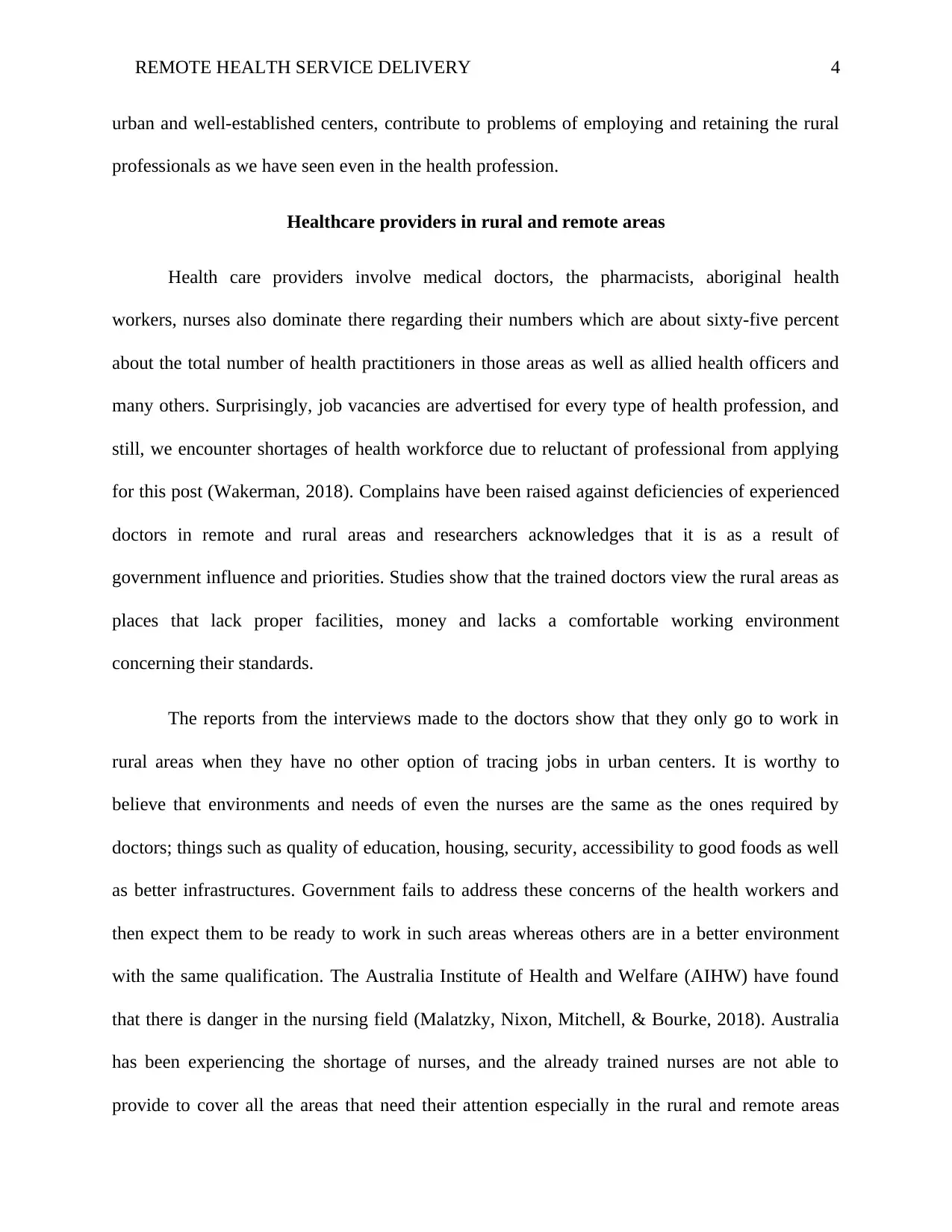
REMOTE HEALTH SERVICE DELIVERY 4
urban and well-established centers, contribute to problems of employing and retaining the rural
professionals as we have seen even in the health profession.
Healthcare providers in rural and remote areas
Health care providers involve medical doctors, the pharmacists, aboriginal health
workers, nurses also dominate there regarding their numbers which are about sixty-five percent
about the total number of health practitioners in those areas as well as allied health officers and
many others. Surprisingly, job vacancies are advertised for every type of health profession, and
still, we encounter shortages of health workforce due to reluctant of professional from applying
for this post (Wakerman, 2018). Complains have been raised against deficiencies of experienced
doctors in remote and rural areas and researchers acknowledges that it is as a result of
government influence and priorities. Studies show that the trained doctors view the rural areas as
places that lack proper facilities, money and lacks a comfortable working environment
concerning their standards.
The reports from the interviews made to the doctors show that they only go to work in
rural areas when they have no other option of tracing jobs in urban centers. It is worthy to
believe that environments and needs of even the nurses are the same as the ones required by
doctors; things such as quality of education, housing, security, accessibility to good foods as well
as better infrastructures. Government fails to address these concerns of the health workers and
then expect them to be ready to work in such areas whereas others are in a better environment
with the same qualification. The Australia Institute of Health and Welfare (AIHW) have found
that there is danger in the nursing field (Malatzky, Nixon, Mitchell, & Bourke, 2018). Australia
has been experiencing the shortage of nurses, and the already trained nurses are not able to
provide to cover all the areas that need their attention especially in the rural and remote areas
urban and well-established centers, contribute to problems of employing and retaining the rural
professionals as we have seen even in the health profession.
Healthcare providers in rural and remote areas
Health care providers involve medical doctors, the pharmacists, aboriginal health
workers, nurses also dominate there regarding their numbers which are about sixty-five percent
about the total number of health practitioners in those areas as well as allied health officers and
many others. Surprisingly, job vacancies are advertised for every type of health profession, and
still, we encounter shortages of health workforce due to reluctant of professional from applying
for this post (Wakerman, 2018). Complains have been raised against deficiencies of experienced
doctors in remote and rural areas and researchers acknowledges that it is as a result of
government influence and priorities. Studies show that the trained doctors view the rural areas as
places that lack proper facilities, money and lacks a comfortable working environment
concerning their standards.
The reports from the interviews made to the doctors show that they only go to work in
rural areas when they have no other option of tracing jobs in urban centers. It is worthy to
believe that environments and needs of even the nurses are the same as the ones required by
doctors; things such as quality of education, housing, security, accessibility to good foods as well
as better infrastructures. Government fails to address these concerns of the health workers and
then expect them to be ready to work in such areas whereas others are in a better environment
with the same qualification. The Australia Institute of Health and Welfare (AIHW) have found
that there is danger in the nursing field (Malatzky, Nixon, Mitchell, & Bourke, 2018). Australia
has been experiencing the shortage of nurses, and the already trained nurses are not able to
provide to cover all the areas that need their attention especially in the rural and remote areas
Secure Best Marks with AI Grader
Need help grading? Try our AI Grader for instant feedback on your assignments.
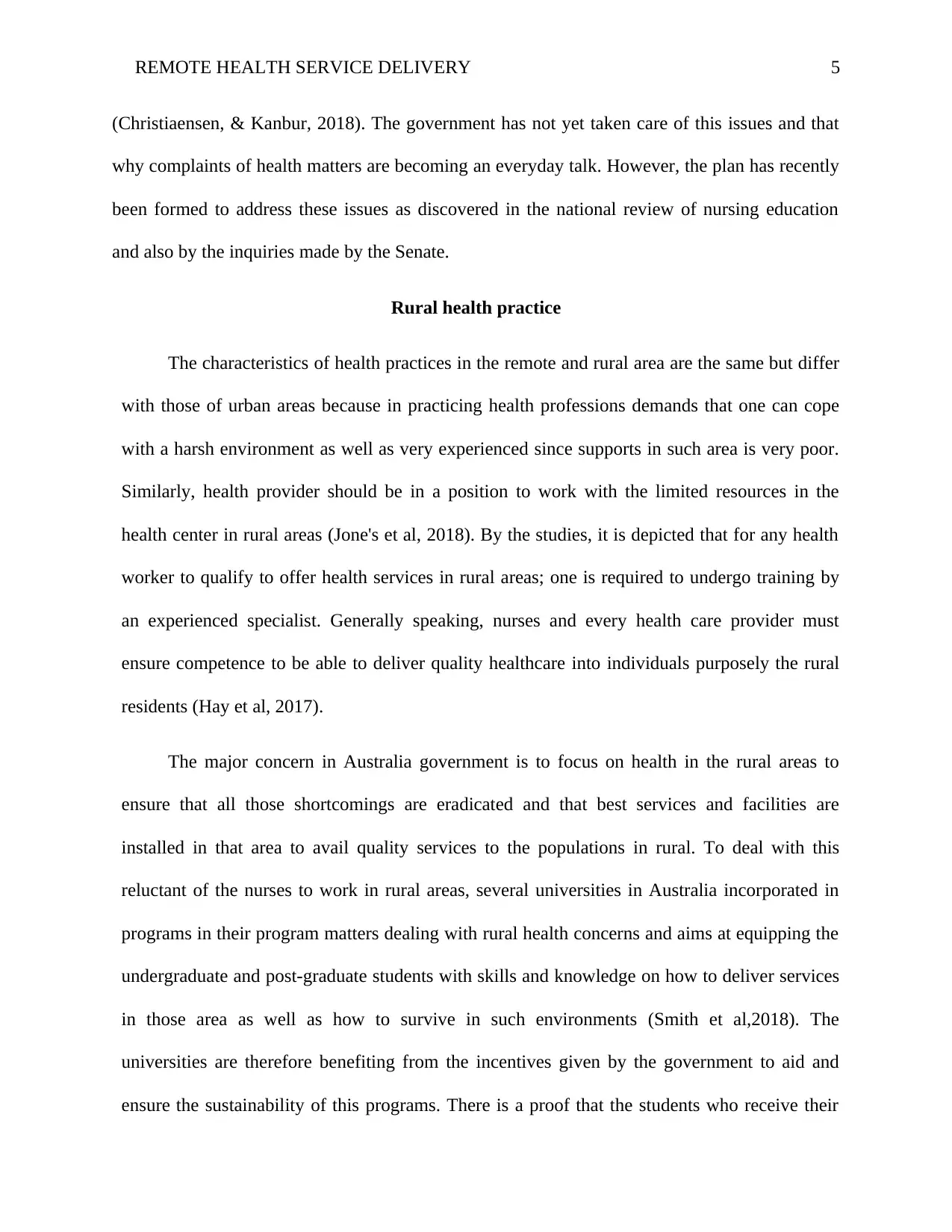
REMOTE HEALTH SERVICE DELIVERY 5
(Christiaensen, & Kanbur, 2018). The government has not yet taken care of this issues and that
why complaints of health matters are becoming an everyday talk. However, the plan has recently
been formed to address these issues as discovered in the national review of nursing education
and also by the inquiries made by the Senate.
Rural health practice
The characteristics of health practices in the remote and rural area are the same but differ
with those of urban areas because in practicing health professions demands that one can cope
with a harsh environment as well as very experienced since supports in such area is very poor.
Similarly, health provider should be in a position to work with the limited resources in the
health center in rural areas (Jone's et al, 2018). By the studies, it is depicted that for any health
worker to qualify to offer health services in rural areas; one is required to undergo training by
an experienced specialist. Generally speaking, nurses and every health care provider must
ensure competence to be able to deliver quality healthcare into individuals purposely the rural
residents (Hay et al, 2017).
The major concern in Australia government is to focus on health in the rural areas to
ensure that all those shortcomings are eradicated and that best services and facilities are
installed in that area to avail quality services to the populations in rural. To deal with this
reluctant of the nurses to work in rural areas, several universities in Australia incorporated in
programs in their program matters dealing with rural health concerns and aims at equipping the
undergraduate and post-graduate students with skills and knowledge on how to deliver services
in those area as well as how to survive in such environments (Smith et al,2018). The
universities are therefore benefiting from the incentives given by the government to aid and
ensure the sustainability of this programs. There is a proof that the students who receive their
(Christiaensen, & Kanbur, 2018). The government has not yet taken care of this issues and that
why complaints of health matters are becoming an everyday talk. However, the plan has recently
been formed to address these issues as discovered in the national review of nursing education
and also by the inquiries made by the Senate.
Rural health practice
The characteristics of health practices in the remote and rural area are the same but differ
with those of urban areas because in practicing health professions demands that one can cope
with a harsh environment as well as very experienced since supports in such area is very poor.
Similarly, health provider should be in a position to work with the limited resources in the
health center in rural areas (Jone's et al, 2018). By the studies, it is depicted that for any health
worker to qualify to offer health services in rural areas; one is required to undergo training by
an experienced specialist. Generally speaking, nurses and every health care provider must
ensure competence to be able to deliver quality healthcare into individuals purposely the rural
residents (Hay et al, 2017).
The major concern in Australia government is to focus on health in the rural areas to
ensure that all those shortcomings are eradicated and that best services and facilities are
installed in that area to avail quality services to the populations in rural. To deal with this
reluctant of the nurses to work in rural areas, several universities in Australia incorporated in
programs in their program matters dealing with rural health concerns and aims at equipping the
undergraduate and post-graduate students with skills and knowledge on how to deliver services
in those area as well as how to survive in such environments (Smith et al,2018). The
universities are therefore benefiting from the incentives given by the government to aid and
ensure the sustainability of this programs. There is a proof that the students who receive their
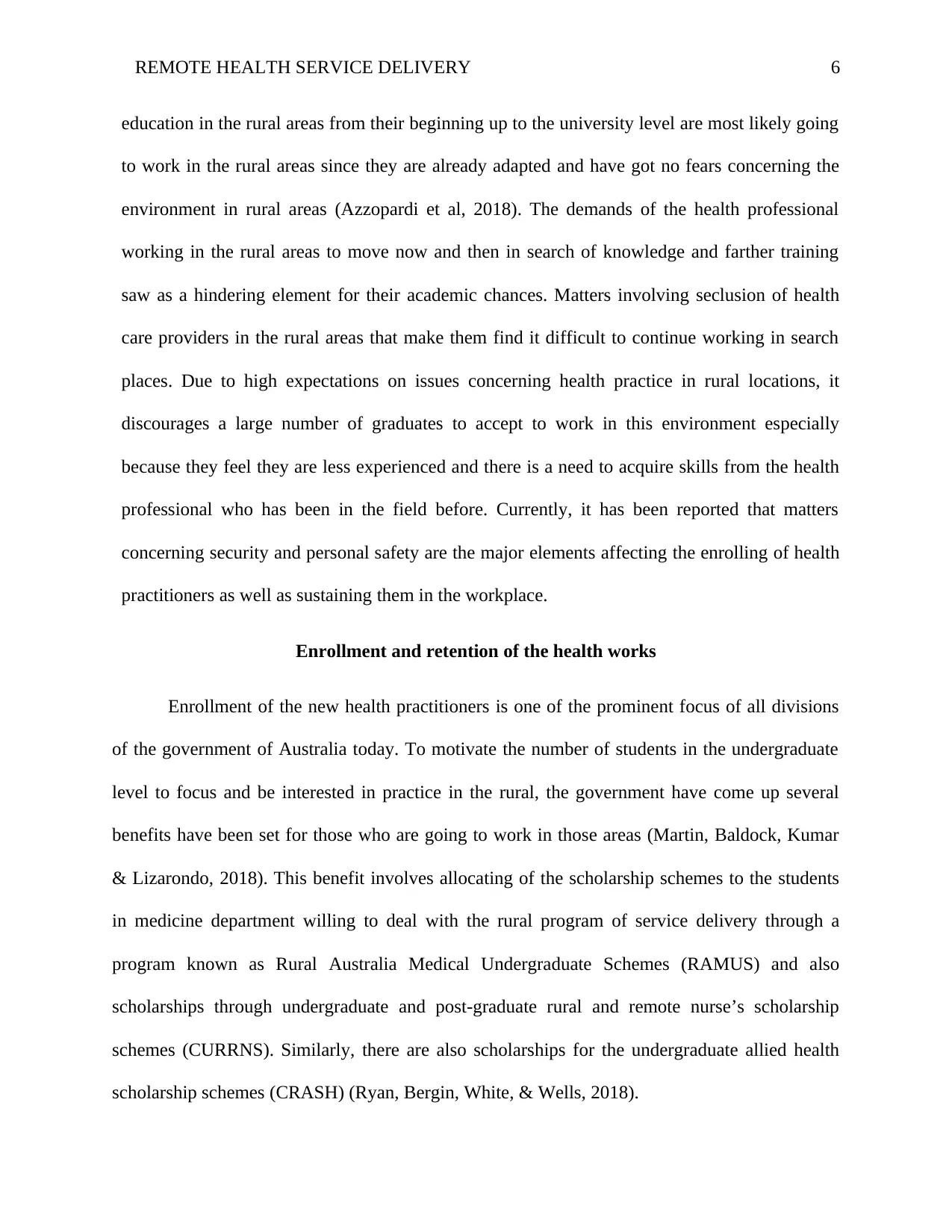
REMOTE HEALTH SERVICE DELIVERY 6
education in the rural areas from their beginning up to the university level are most likely going
to work in the rural areas since they are already adapted and have got no fears concerning the
environment in rural areas (Azzopardi et al, 2018). The demands of the health professional
working in the rural areas to move now and then in search of knowledge and farther training
saw as a hindering element for their academic chances. Matters involving seclusion of health
care providers in the rural areas that make them find it difficult to continue working in search
places. Due to high expectations on issues concerning health practice in rural locations, it
discourages a large number of graduates to accept to work in this environment especially
because they feel they are less experienced and there is a need to acquire skills from the health
professional who has been in the field before. Currently, it has been reported that matters
concerning security and personal safety are the major elements affecting the enrolling of health
practitioners as well as sustaining them in the workplace.
Enrollment and retention of the health works
Enrollment of the new health practitioners is one of the prominent focus of all divisions
of the government of Australia today. To motivate the number of students in the undergraduate
level to focus and be interested in practice in the rural, the government have come up several
benefits have been set for those who are going to work in those areas (Martin, Baldock, Kumar
& Lizarondo, 2018). This benefit involves allocating of the scholarship schemes to the students
in medicine department willing to deal with the rural program of service delivery through a
program known as Rural Australia Medical Undergraduate Schemes (RAMUS) and also
scholarships through undergraduate and post-graduate rural and remote nurse’s scholarship
schemes (CURRNS). Similarly, there are also scholarships for the undergraduate allied health
scholarship schemes (CRASH) (Ryan, Bergin, White, & Wells, 2018).
education in the rural areas from their beginning up to the university level are most likely going
to work in the rural areas since they are already adapted and have got no fears concerning the
environment in rural areas (Azzopardi et al, 2018). The demands of the health professional
working in the rural areas to move now and then in search of knowledge and farther training
saw as a hindering element for their academic chances. Matters involving seclusion of health
care providers in the rural areas that make them find it difficult to continue working in search
places. Due to high expectations on issues concerning health practice in rural locations, it
discourages a large number of graduates to accept to work in this environment especially
because they feel they are less experienced and there is a need to acquire skills from the health
professional who has been in the field before. Currently, it has been reported that matters
concerning security and personal safety are the major elements affecting the enrolling of health
practitioners as well as sustaining them in the workplace.
Enrollment and retention of the health works
Enrollment of the new health practitioners is one of the prominent focus of all divisions
of the government of Australia today. To motivate the number of students in the undergraduate
level to focus and be interested in practice in the rural, the government have come up several
benefits have been set for those who are going to work in those areas (Martin, Baldock, Kumar
& Lizarondo, 2018). This benefit involves allocating of the scholarship schemes to the students
in medicine department willing to deal with the rural program of service delivery through a
program known as Rural Australia Medical Undergraduate Schemes (RAMUS) and also
scholarships through undergraduate and post-graduate rural and remote nurse’s scholarship
schemes (CURRNS). Similarly, there are also scholarships for the undergraduate allied health
scholarship schemes (CRASH) (Ryan, Bergin, White, & Wells, 2018).
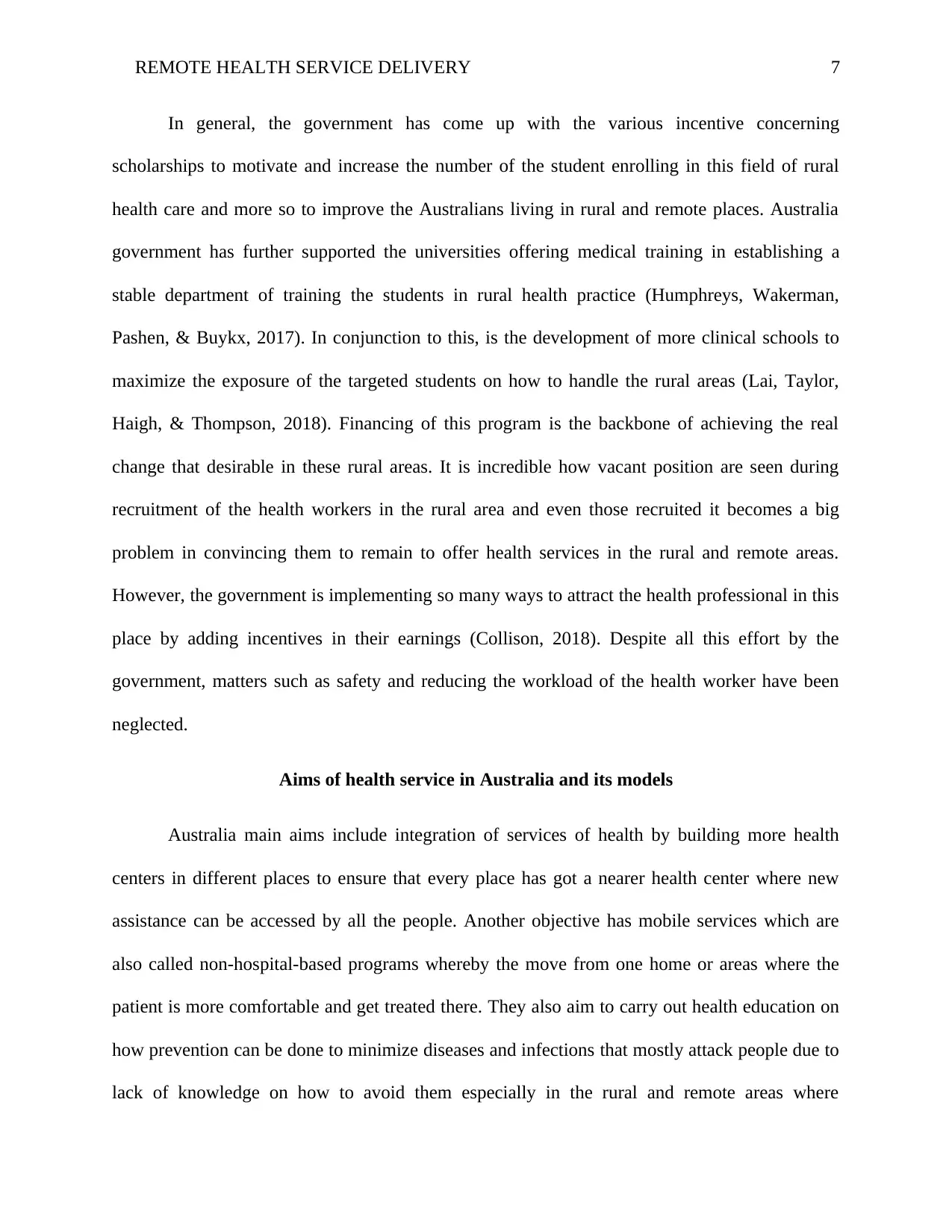
REMOTE HEALTH SERVICE DELIVERY 7
In general, the government has come up with the various incentive concerning
scholarships to motivate and increase the number of the student enrolling in this field of rural
health care and more so to improve the Australians living in rural and remote places. Australia
government has further supported the universities offering medical training in establishing a
stable department of training the students in rural health practice (Humphreys, Wakerman,
Pashen, & Buykx, 2017). In conjunction to this, is the development of more clinical schools to
maximize the exposure of the targeted students on how to handle the rural areas (Lai, Taylor,
Haigh, & Thompson, 2018). Financing of this program is the backbone of achieving the real
change that desirable in these rural areas. It is incredible how vacant position are seen during
recruitment of the health workers in the rural area and even those recruited it becomes a big
problem in convincing them to remain to offer health services in the rural and remote areas.
However, the government is implementing so many ways to attract the health professional in this
place by adding incentives in their earnings (Collison, 2018). Despite all this effort by the
government, matters such as safety and reducing the workload of the health worker have been
neglected.
Aims of health service in Australia and its models
Australia main aims include integration of services of health by building more health
centers in different places to ensure that every place has got a nearer health center where new
assistance can be accessed by all the people. Another objective has mobile services which are
also called non-hospital-based programs whereby the move from one home or areas where the
patient is more comfortable and get treated there. They also aim to carry out health education on
how prevention can be done to minimize diseases and infections that mostly attack people due to
lack of knowledge on how to avoid them especially in the rural and remote areas where
In general, the government has come up with the various incentive concerning
scholarships to motivate and increase the number of the student enrolling in this field of rural
health care and more so to improve the Australians living in rural and remote places. Australia
government has further supported the universities offering medical training in establishing a
stable department of training the students in rural health practice (Humphreys, Wakerman,
Pashen, & Buykx, 2017). In conjunction to this, is the development of more clinical schools to
maximize the exposure of the targeted students on how to handle the rural areas (Lai, Taylor,
Haigh, & Thompson, 2018). Financing of this program is the backbone of achieving the real
change that desirable in these rural areas. It is incredible how vacant position are seen during
recruitment of the health workers in the rural area and even those recruited it becomes a big
problem in convincing them to remain to offer health services in the rural and remote areas.
However, the government is implementing so many ways to attract the health professional in this
place by adding incentives in their earnings (Collison, 2018). Despite all this effort by the
government, matters such as safety and reducing the workload of the health worker have been
neglected.
Aims of health service in Australia and its models
Australia main aims include integration of services of health by building more health
centers in different places to ensure that every place has got a nearer health center where new
assistance can be accessed by all the people. Another objective has mobile services which are
also called non-hospital-based programs whereby the move from one home or areas where the
patient is more comfortable and get treated there. They also aim to carry out health education on
how prevention can be done to minimize diseases and infections that mostly attack people due to
lack of knowledge on how to avoid them especially in the rural and remote areas where
Paraphrase This Document
Need a fresh take? Get an instant paraphrase of this document with our AI Paraphraser
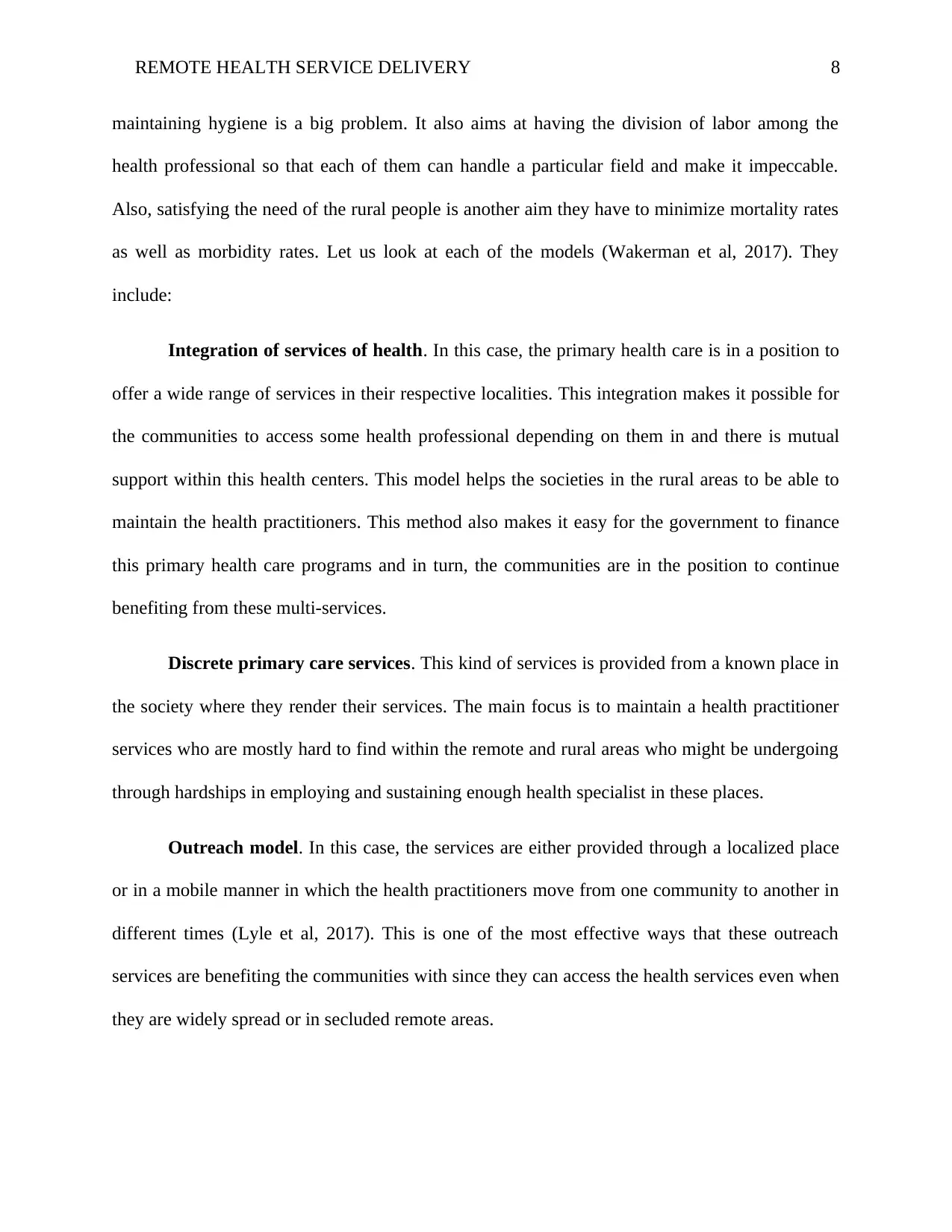
REMOTE HEALTH SERVICE DELIVERY 8
maintaining hygiene is a big problem. It also aims at having the division of labor among the
health professional so that each of them can handle a particular field and make it impeccable.
Also, satisfying the need of the rural people is another aim they have to minimize mortality rates
as well as morbidity rates. Let us look at each of the models (Wakerman et al, 2017). They
include:
Integration of services of health. In this case, the primary health care is in a position to
offer a wide range of services in their respective localities. This integration makes it possible for
the communities to access some health professional depending on them in and there is mutual
support within this health centers. This model helps the societies in the rural areas to be able to
maintain the health practitioners. This method also makes it easy for the government to finance
this primary health care programs and in turn, the communities are in the position to continue
benefiting from these multi-services.
Discrete primary care services. This kind of services is provided from a known place in
the society where they render their services. The main focus is to maintain a health practitioner
services who are mostly hard to find within the remote and rural areas who might be undergoing
through hardships in employing and sustaining enough health specialist in these places.
Outreach model. In this case, the services are either provided through a localized place
or in a mobile manner in which the health practitioners move from one community to another in
different times (Lyle et al, 2017). This is one of the most effective ways that these outreach
services are benefiting the communities with since they can access the health services even when
they are widely spread or in secluded remote areas.
maintaining hygiene is a big problem. It also aims at having the division of labor among the
health professional so that each of them can handle a particular field and make it impeccable.
Also, satisfying the need of the rural people is another aim they have to minimize mortality rates
as well as morbidity rates. Let us look at each of the models (Wakerman et al, 2017). They
include:
Integration of services of health. In this case, the primary health care is in a position to
offer a wide range of services in their respective localities. This integration makes it possible for
the communities to access some health professional depending on them in and there is mutual
support within this health centers. This model helps the societies in the rural areas to be able to
maintain the health practitioners. This method also makes it easy for the government to finance
this primary health care programs and in turn, the communities are in the position to continue
benefiting from these multi-services.
Discrete primary care services. This kind of services is provided from a known place in
the society where they render their services. The main focus is to maintain a health practitioner
services who are mostly hard to find within the remote and rural areas who might be undergoing
through hardships in employing and sustaining enough health specialist in these places.
Outreach model. In this case, the services are either provided through a localized place
or in a mobile manner in which the health practitioners move from one community to another in
different times (Lyle et al, 2017). This is one of the most effective ways that these outreach
services are benefiting the communities with since they can access the health services even when
they are widely spread or in secluded remote areas.
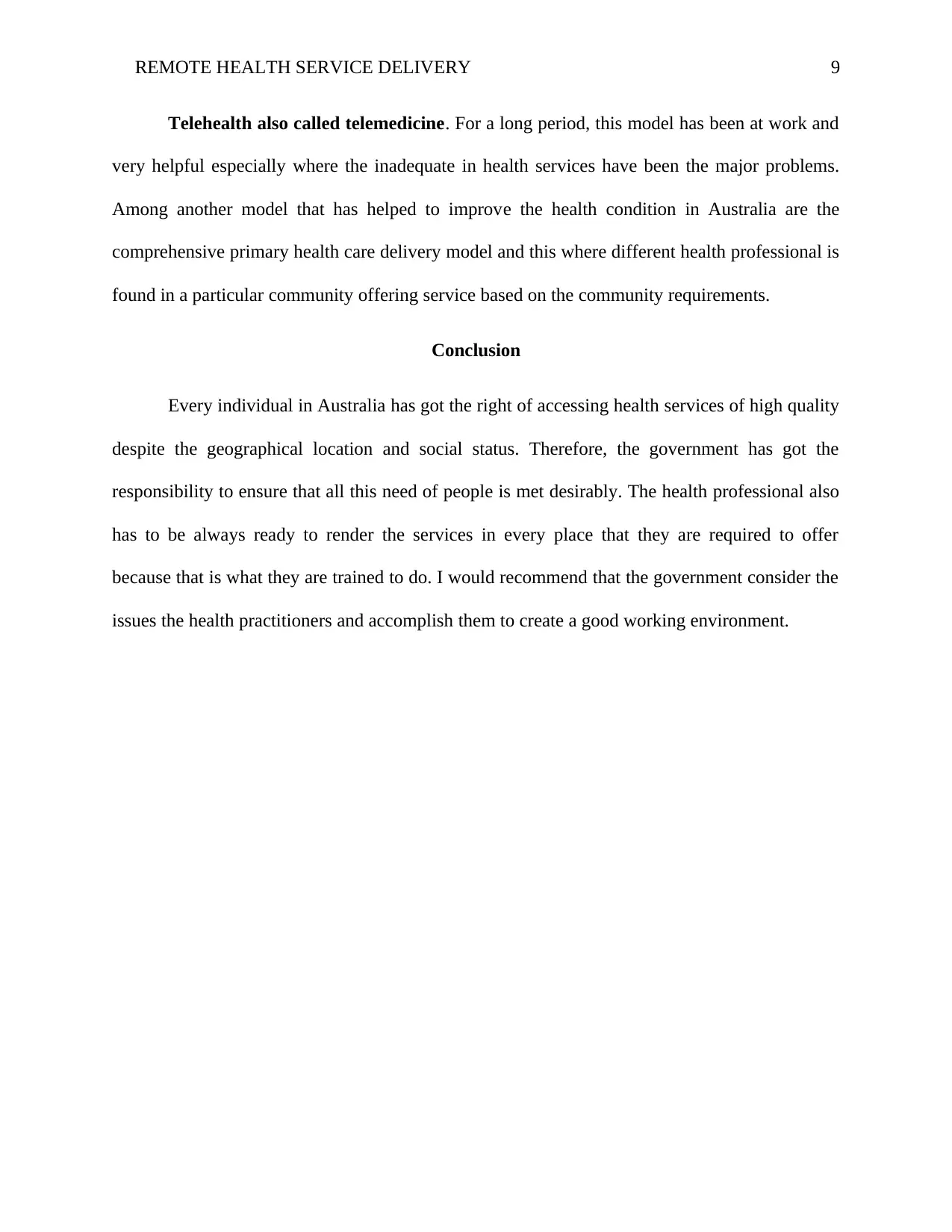
REMOTE HEALTH SERVICE DELIVERY 9
Telehealth also called telemedicine. For a long period, this model has been at work and
very helpful especially where the inadequate in health services have been the major problems.
Among another model that has helped to improve the health condition in Australia are the
comprehensive primary health care delivery model and this where different health professional is
found in a particular community offering service based on the community requirements.
Conclusion
Every individual in Australia has got the right of accessing health services of high quality
despite the geographical location and social status. Therefore, the government has got the
responsibility to ensure that all this need of people is met desirably. The health professional also
has to be always ready to render the services in every place that they are required to offer
because that is what they are trained to do. I would recommend that the government consider the
issues the health practitioners and accomplish them to create a good working environment.
Telehealth also called telemedicine. For a long period, this model has been at work and
very helpful especially where the inadequate in health services have been the major problems.
Among another model that has helped to improve the health condition in Australia are the
comprehensive primary health care delivery model and this where different health professional is
found in a particular community offering service based on the community requirements.
Conclusion
Every individual in Australia has got the right of accessing health services of high quality
despite the geographical location and social status. Therefore, the government has got the
responsibility to ensure that all this need of people is met desirably. The health professional also
has to be always ready to render the services in every place that they are required to offer
because that is what they are trained to do. I would recommend that the government consider the
issues the health practitioners and accomplish them to create a good working environment.
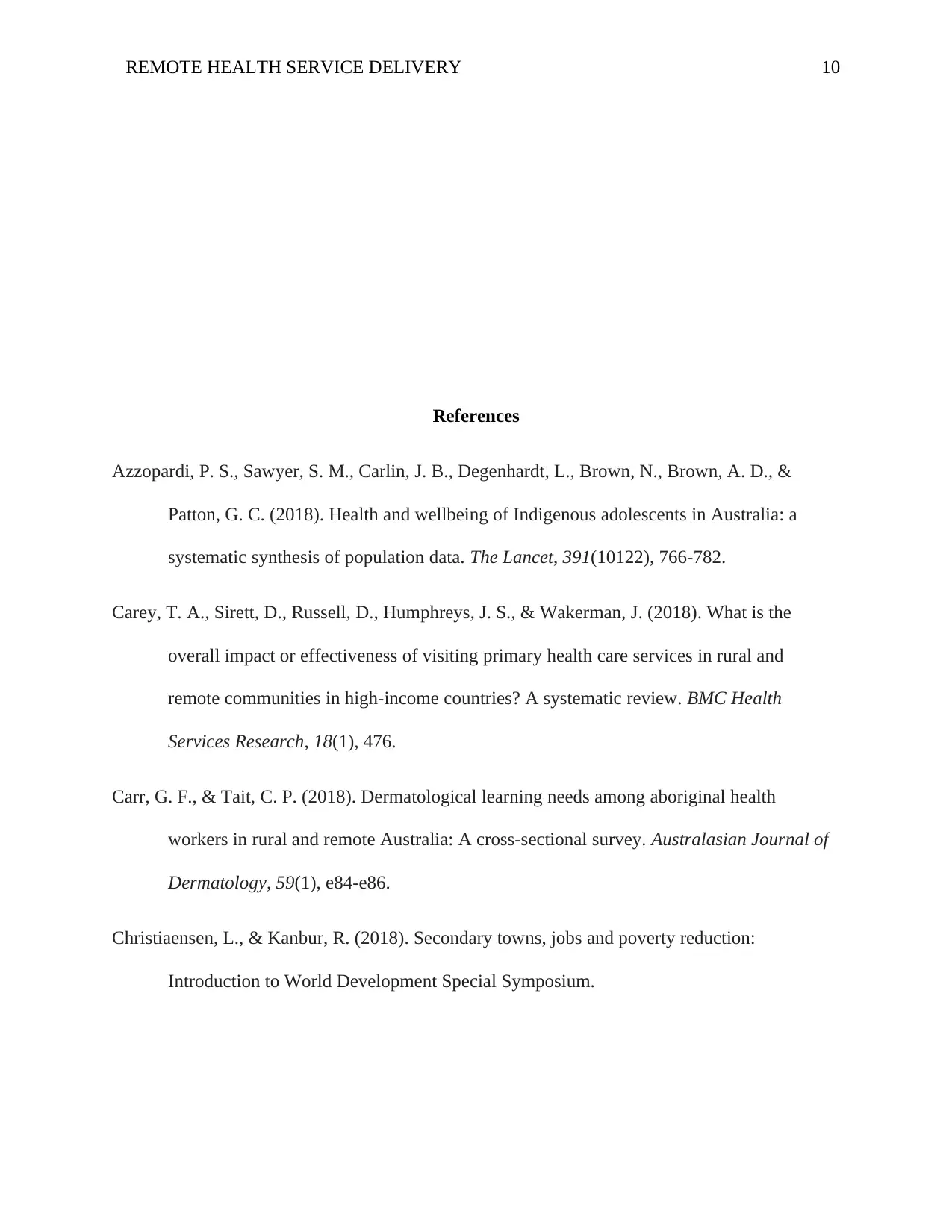
REMOTE HEALTH SERVICE DELIVERY 10
References
Azzopardi, P. S., Sawyer, S. M., Carlin, J. B., Degenhardt, L., Brown, N., Brown, A. D., &
Patton, G. C. (2018). Health and wellbeing of Indigenous adolescents in Australia: a
systematic synthesis of population data. The Lancet, 391(10122), 766-782.
Carey, T. A., Sirett, D., Russell, D., Humphreys, J. S., & Wakerman, J. (2018). What is the
overall impact or effectiveness of visiting primary health care services in rural and
remote communities in high-income countries? A systematic review. BMC Health
Services Research, 18(1), 476.
Carr, G. F., & Tait, C. P. (2018). Dermatological learning needs among aboriginal health
workers in rural and remote Australia: A cross‐sectional survey. Australasian Journal of
Dermatology, 59(1), e84-e86.
Christiaensen, L., & Kanbur, R. (2018). Secondary towns, jobs and poverty reduction:
Introduction to World Development Special Symposium.
References
Azzopardi, P. S., Sawyer, S. M., Carlin, J. B., Degenhardt, L., Brown, N., Brown, A. D., &
Patton, G. C. (2018). Health and wellbeing of Indigenous adolescents in Australia: a
systematic synthesis of population data. The Lancet, 391(10122), 766-782.
Carey, T. A., Sirett, D., Russell, D., Humphreys, J. S., & Wakerman, J. (2018). What is the
overall impact or effectiveness of visiting primary health care services in rural and
remote communities in high-income countries? A systematic review. BMC Health
Services Research, 18(1), 476.
Carr, G. F., & Tait, C. P. (2018). Dermatological learning needs among aboriginal health
workers in rural and remote Australia: A cross‐sectional survey. Australasian Journal of
Dermatology, 59(1), e84-e86.
Christiaensen, L., & Kanbur, R. (2018). Secondary towns, jobs and poverty reduction:
Introduction to World Development Special Symposium.
Secure Best Marks with AI Grader
Need help grading? Try our AI Grader for instant feedback on your assignments.
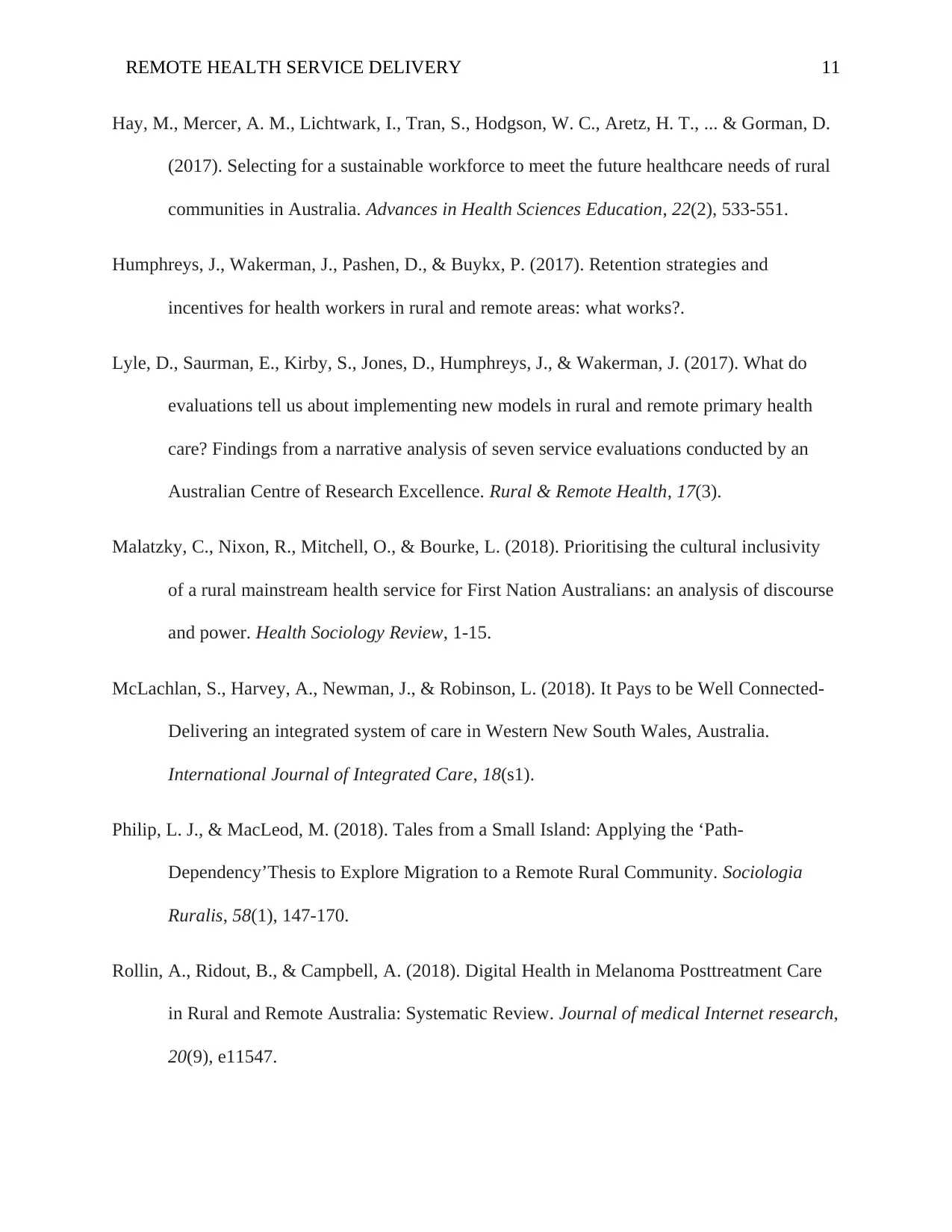
REMOTE HEALTH SERVICE DELIVERY 11
Hay, M., Mercer, A. M., Lichtwark, I., Tran, S., Hodgson, W. C., Aretz, H. T., ... & Gorman, D.
(2017). Selecting for a sustainable workforce to meet the future healthcare needs of rural
communities in Australia. Advances in Health Sciences Education, 22(2), 533-551.
Humphreys, J., Wakerman, J., Pashen, D., & Buykx, P. (2017). Retention strategies and
incentives for health workers in rural and remote areas: what works?.
Lyle, D., Saurman, E., Kirby, S., Jones, D., Humphreys, J., & Wakerman, J. (2017). What do
evaluations tell us about implementing new models in rural and remote primary health
care? Findings from a narrative analysis of seven service evaluations conducted by an
Australian Centre of Research Excellence. Rural & Remote Health, 17(3).
Malatzky, C., Nixon, R., Mitchell, O., & Bourke, L. (2018). Prioritising the cultural inclusivity
of a rural mainstream health service for First Nation Australians: an analysis of discourse
and power. Health Sociology Review, 1-15.
McLachlan, S., Harvey, A., Newman, J., & Robinson, L. (2018). It Pays to be Well Connected-
Delivering an integrated system of care in Western New South Wales, Australia.
International Journal of Integrated Care, 18(s1).
Philip, L. J., & MacLeod, M. (2018). Tales from a Small Island: Applying the ‘Path‐
Dependency’Thesis to Explore Migration to a Remote Rural Community. Sociologia
Ruralis, 58(1), 147-170.
Rollin, A., Ridout, B., & Campbell, A. (2018). Digital Health in Melanoma Posttreatment Care
in Rural and Remote Australia: Systematic Review. Journal of medical Internet research,
20(9), e11547.
Hay, M., Mercer, A. M., Lichtwark, I., Tran, S., Hodgson, W. C., Aretz, H. T., ... & Gorman, D.
(2017). Selecting for a sustainable workforce to meet the future healthcare needs of rural
communities in Australia. Advances in Health Sciences Education, 22(2), 533-551.
Humphreys, J., Wakerman, J., Pashen, D., & Buykx, P. (2017). Retention strategies and
incentives for health workers in rural and remote areas: what works?.
Lyle, D., Saurman, E., Kirby, S., Jones, D., Humphreys, J., & Wakerman, J. (2017). What do
evaluations tell us about implementing new models in rural and remote primary health
care? Findings from a narrative analysis of seven service evaluations conducted by an
Australian Centre of Research Excellence. Rural & Remote Health, 17(3).
Malatzky, C., Nixon, R., Mitchell, O., & Bourke, L. (2018). Prioritising the cultural inclusivity
of a rural mainstream health service for First Nation Australians: an analysis of discourse
and power. Health Sociology Review, 1-15.
McLachlan, S., Harvey, A., Newman, J., & Robinson, L. (2018). It Pays to be Well Connected-
Delivering an integrated system of care in Western New South Wales, Australia.
International Journal of Integrated Care, 18(s1).
Philip, L. J., & MacLeod, M. (2018). Tales from a Small Island: Applying the ‘Path‐
Dependency’Thesis to Explore Migration to a Remote Rural Community. Sociologia
Ruralis, 58(1), 147-170.
Rollin, A., Ridout, B., & Campbell, A. (2018). Digital Health in Melanoma Posttreatment Care
in Rural and Remote Australia: Systematic Review. Journal of medical Internet research,
20(9), e11547.
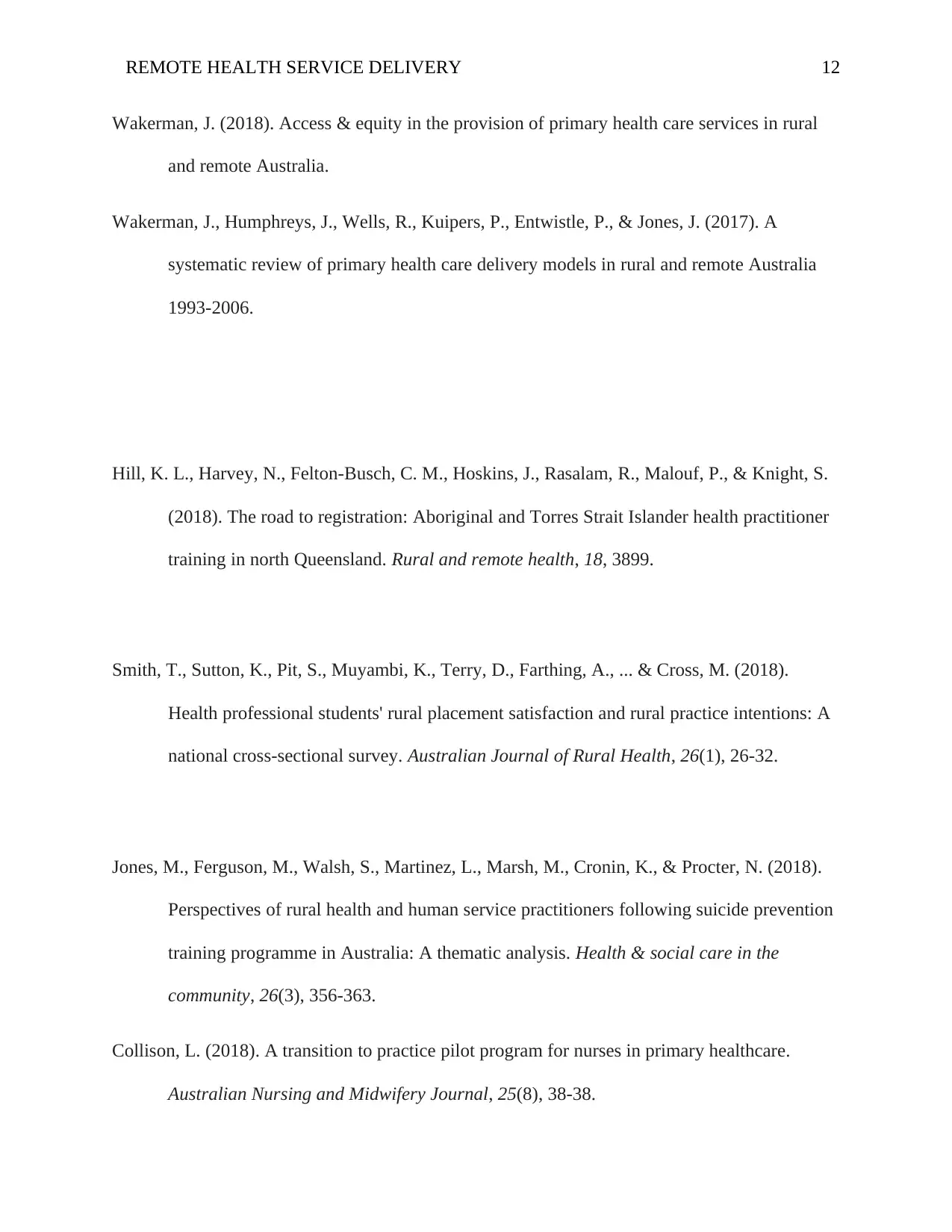
REMOTE HEALTH SERVICE DELIVERY 12
Wakerman, J. (2018). Access & equity in the provision of primary health care services in rural
and remote Australia.
Wakerman, J., Humphreys, J., Wells, R., Kuipers, P., Entwistle, P., & Jones, J. (2017). A
systematic review of primary health care delivery models in rural and remote Australia
1993-2006.
Hill, K. L., Harvey, N., Felton-Busch, C. M., Hoskins, J., Rasalam, R., Malouf, P., & Knight, S.
(2018). The road to registration: Aboriginal and Torres Strait Islander health practitioner
training in north Queensland. Rural and remote health, 18, 3899.
Smith, T., Sutton, K., Pit, S., Muyambi, K., Terry, D., Farthing, A., ... & Cross, M. (2018).
Health professional students' rural placement satisfaction and rural practice intentions: A
national cross‐sectional survey. Australian Journal of Rural Health, 26(1), 26-32.
Jones, M., Ferguson, M., Walsh, S., Martinez, L., Marsh, M., Cronin, K., & Procter, N. (2018).
Perspectives of rural health and human service practitioners following suicide prevention
training programme in Australia: A thematic analysis. Health & social care in the
community, 26(3), 356-363.
Collison, L. (2018). A transition to practice pilot program for nurses in primary healthcare.
Australian Nursing and Midwifery Journal, 25(8), 38-38.
Wakerman, J. (2018). Access & equity in the provision of primary health care services in rural
and remote Australia.
Wakerman, J., Humphreys, J., Wells, R., Kuipers, P., Entwistle, P., & Jones, J. (2017). A
systematic review of primary health care delivery models in rural and remote Australia
1993-2006.
Hill, K. L., Harvey, N., Felton-Busch, C. M., Hoskins, J., Rasalam, R., Malouf, P., & Knight, S.
(2018). The road to registration: Aboriginal and Torres Strait Islander health practitioner
training in north Queensland. Rural and remote health, 18, 3899.
Smith, T., Sutton, K., Pit, S., Muyambi, K., Terry, D., Farthing, A., ... & Cross, M. (2018).
Health professional students' rural placement satisfaction and rural practice intentions: A
national cross‐sectional survey. Australian Journal of Rural Health, 26(1), 26-32.
Jones, M., Ferguson, M., Walsh, S., Martinez, L., Marsh, M., Cronin, K., & Procter, N. (2018).
Perspectives of rural health and human service practitioners following suicide prevention
training programme in Australia: A thematic analysis. Health & social care in the
community, 26(3), 356-363.
Collison, L. (2018). A transition to practice pilot program for nurses in primary healthcare.
Australian Nursing and Midwifery Journal, 25(8), 38-38.
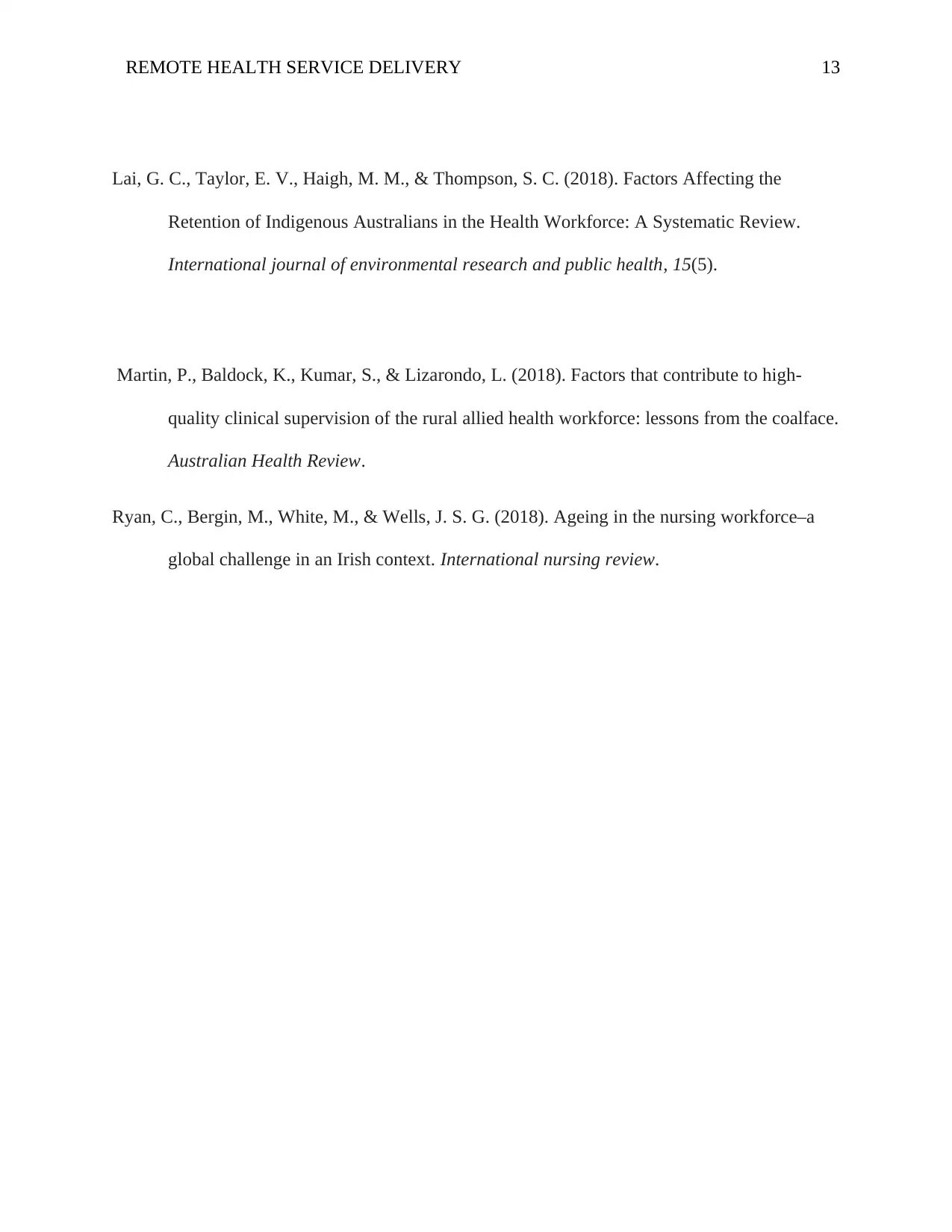
REMOTE HEALTH SERVICE DELIVERY 13
Lai, G. C., Taylor, E. V., Haigh, M. M., & Thompson, S. C. (2018). Factors Affecting the
Retention of Indigenous Australians in the Health Workforce: A Systematic Review.
International journal of environmental research and public health, 15(5).
Martin, P., Baldock, K., Kumar, S., & Lizarondo, L. (2018). Factors that contribute to high-
quality clinical supervision of the rural allied health workforce: lessons from the coalface.
Australian Health Review.
Ryan, C., Bergin, M., White, M., & Wells, J. S. G. (2018). Ageing in the nursing workforce–a
global challenge in an Irish context. International nursing review.
Lai, G. C., Taylor, E. V., Haigh, M. M., & Thompson, S. C. (2018). Factors Affecting the
Retention of Indigenous Australians in the Health Workforce: A Systematic Review.
International journal of environmental research and public health, 15(5).
Martin, P., Baldock, K., Kumar, S., & Lizarondo, L. (2018). Factors that contribute to high-
quality clinical supervision of the rural allied health workforce: lessons from the coalface.
Australian Health Review.
Ryan, C., Bergin, M., White, M., & Wells, J. S. G. (2018). Ageing in the nursing workforce–a
global challenge in an Irish context. International nursing review.
Paraphrase This Document
Need a fresh take? Get an instant paraphrase of this document with our AI Paraphraser
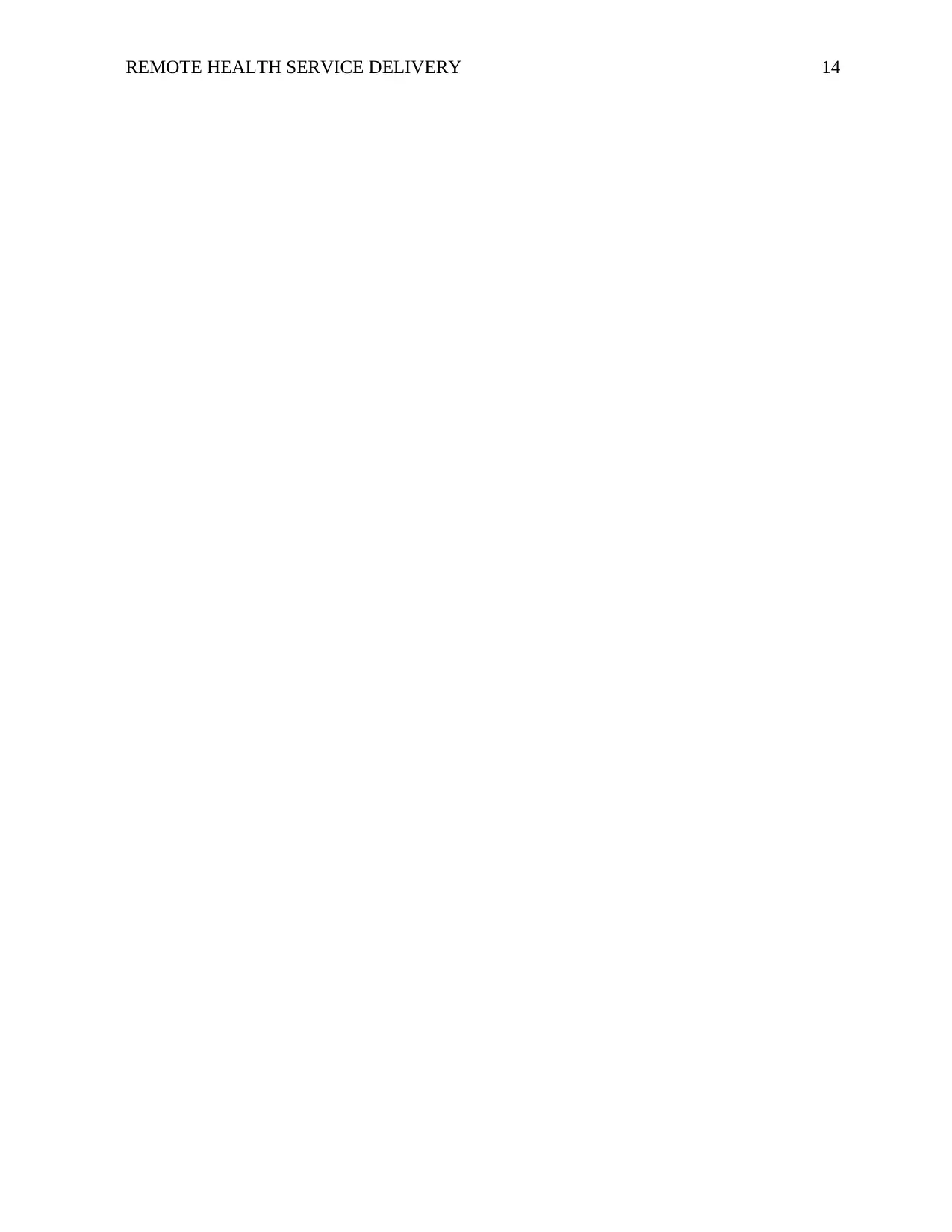
REMOTE HEALTH SERVICE DELIVERY 14
1 out of 14
Related Documents
Your All-in-One AI-Powered Toolkit for Academic Success.
+13062052269
info@desklib.com
Available 24*7 on WhatsApp / Email
![[object Object]](/_next/static/media/star-bottom.7253800d.svg)
Unlock your academic potential
© 2024 | Zucol Services PVT LTD | All rights reserved.





